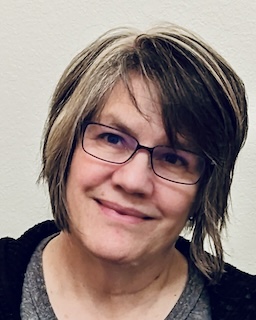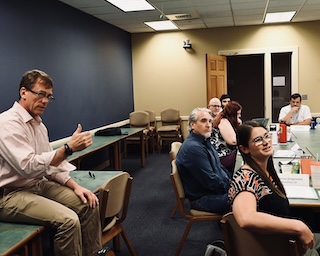
Anna Lenardson Loves to Learn and Teach

If you ask Anna Lenardson, a 2023 graduate of Ashland University’s Master of Arts in American History and Government (MAHG) program, why she enrolled in the challenging program, she replies, “I love to learn. I loved being with other teachers, talking about history and government.” True, she had to complete a lot of reading before arriving at the weeklong residential summer courses. But doing so prepared her for a week of intense, revelatory conversation. Online interactive evening courses during the school year required a different kind of focus—engaging in discussion after a long school day. “But the online courses allowed us to spread out our reading over eight weeks,” she says. “I enjoyed every minute of the program.”
She learned about MAHG in 2018, at a one-day TAH seminar offered in Tulsa on the American Founding. As the facilitator, Professor Jason Stevens, drew all the teachers in the room into discussion, she wondered, “Where can I get more interaction like this?” At the end of the seminar, a TAH representative told participants about Ashland’s Master’s program and the possibility of funding MAHG studies through a .
Intrigued, Lenardson attended a residential MAHG seminar in Ashland the next summer on “The Civil War in History and Literature,” taught by Professors and Kathy Pfeiffer. A week of constant conversation—during seminar sessions, meals, and evening study time—“led to a couple of lasting relationships” with fellow teachers. She applied for the Madison fellowship, was awarded it in the spring of 2020, and enrolled at once in MAHG.
A Learner Called to Teach
People who love to learn often find joy in helping others learn, especially if they like “being around kids,” as Lenardson does. Both Lenardson and her husband Robb—whose first career was in business—felt called to teach in mid-life. They moved their family, including children aged sixteen, nine and seven, to Portugal, in order to teach at Cascais International Christian School. Robb taught math, while Anna taught high school English and history, to students from around the world.
After four years overseas, the Lenardsons returned home to work at a boarding school for at-risk students from around the United States, in Oklahoma. They enjoyed helping students from difficult family situations find their strengths in a safe and supportive environment. “The hardest part was seeing kids leave and return home, which could happen suddenly, mid-year,” Lenardson said. “You knew you might never see them again.” She taught history and American government at Cookson Hills for ten years, beginning her MAHG studies during that time.
Now she teaches at the , a charter school in a predominately Hispanic neighborhood that promotes college readiness. “I’ve found my sweet spot, where I can help kids on the brink of adulthood. I watch them spread their wings.”
How MAHG Enhanced Lenardson’s Teaching

Lenardson teaches semester-long courses in Oklahoma History and US Government, and the year-long elective AP US Government course. Her MAHG studies have helped her better serve her students. “I learned enough to pull out a ready answer when a student asks a question,” she says. MAHG offered a wide range of courses on American government. “My course on the Supreme Court with Professor Sikkenga was probably the best I took,” she recalls. “I expected it to be difficult and dry, but not a minute was boring. Whatever issue came up, Sikkenga had a case at his fingertips to offer as an example.”
She benefited equally from the history component of the MAHG curriculum. “I weave a lot of history into my teaching of government, especially the history of the founding era.” Teaching ideas keep coming, because “each class in MAHG built my history nerd network (of fellow teachers) out deeper and wider. This is especially nice when it comes to a last-minute search for resources or lesson ideas. There’s always someone out there with a great idea at their fingertips.”
An Academy for Ambitious Immigrants
Tulsa Honor Academy is a Title I school; about 95% of its students receive free or reduced-price lunch. The school was founded in 2015 by a woman who grew up in the community, who was dismayed that only three youths in her neighborhood—she and her two brothers—went on to college. Too few of the founder’s fellow students even made it to graduation. The honor academy has changed that pattern. “The school started with a fifth-grade class, building out each subsequent grade year by year,” Lenardson explains. “Last June, when we graduated our first class of seniors, 65% of them were the first in their families to complete high school.” Most of the graduates went on to local and state college programs, while a few were accepted to prestigious out-of-state schools, such as George Washington and Emory universities.
Most of Lenardson’s students are first- or second-generation immigrants. They split their days between school and work. “Most take after-school jobs to help their families pay the bills.” They stock shelves in groceries and convenience stores, serve tables in restaurants, help on construction sites or in mechanical repair shops. “When a student asks for an extension on an assignment, I always say yes. I know their work schedules limit study time.”
Learning American History for the First Time
Her students’ families gave them a strong “work ethic,” but few assumptions about American history and government. Unlike those who started school in America, they don’t begin the required high school government course expecting to rehearse old, boring lessons about the three branches of government. And unlike students whose families have been in America for generations, they don’t find high school’s more candid discussions of the unflattering aspects of American history unsettling to their sense of identity. “It’s all news to them; their parents didn’t know to tell them about it,” Lenardson explains. They are curious about the careful structuring of our constitutional system and about constitutional guarantees of rights. When they learn about American failures to protect these rights, they react with surprise and simple “outrage.”
In Oklahoma history, students learn about slavery and the denial of rights during Jim Crow. Instead of struggling to grasp an understanding of federalism that allowed the court decision in Plessy v. Ferguson, they conclude “that the 14th amendment was violated by Jim Crow; that the arguments made by the majority in Plessy were disingenuous. But I don’t think this history discourages them,” Lenardson continues. “It motivates them to guard against violations of their own rights.”

When Lenardson tells students they are responsible for maintaining our democracy, they “get it,” she says. “Last week, one of my students asked, ‘Is this an election year?’ ‘Yes,’ I said, and then I asked, ‘How many of you will be 18 by election day?’ It turned out all of them will be. In Oklahoma, if you will be 18 by election day, you can register to vote at age 17 and a half. So, I said, ‘All right, I’ll bring in registration cards for you all.’ When I did, every student registered.”
Learning to Think for Themselves
Each year, Lenardson reads through the entire Declaration and Constitution with her students. “I like that they can say that they’ve read the Constitution. I give them each a pocket constitution to keep. I tell them to bring it out at Thanksgiving dinner when their uncle gets crazy and to say, ‘I’ve read the Constitution, and I don’t think that’s what it says.’”
Her government students read a long excerpt of Federalist 10 and shorter excerpts of Federalist 51 and 33, along with excerpts from some of the Antifederalists–Brutus II and Patrick Henry. These are ambitious assignments, given that some of Lenardson’s students are learning English as a second language. “Eighteenth century language is difficult even for native English speakers,” Lenardson says. Working as a class or in small groups, students read the excerpts out loud, small segments at a time, parsing out each argument carefully. Then they fill out a chart listing the reasons Americans gave for supporting or opposing ratification of the Constitution. “Students find it difficult at first, but then they get into a groove and begin to understand. My classes tend to be harder than the others they take. But colleagues tell me that my students say they like being challenged. They learn better when they have to figure things out for themselves.”
That is what she hopes for them—that they learn to think for themselves. “It’s not easy to maintain an open mind. To do so, you have to be willing to seek information on all sides of an issue. I recently talked with my AP students about this—how we all want short cuts. It’s easy to attach ourselves to a particular political group and accept a single set of answers to all the problems of government.” But these problems are different, and complicated. Self-governing people “have to put in the work to understand all the options,” Lenardson tells her students. “That’s the active participation that democracy requires.”



